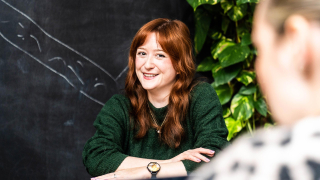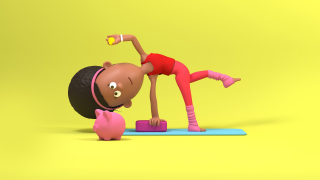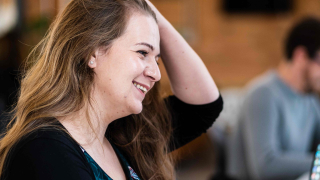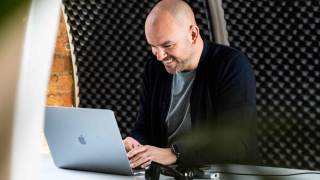
Being neurodiverse can come in many different ‘brands’. For example, ASD, ADHD, dyslexia, dyspraxia and Tourette's syndrome all come under the umbrella of neurodiversity.
We’re wired differently and face many challenges that our neurotypical counterparts may relate to on a surface level, but never fully understand the disabling level in which we experience these challenges.
My personal brand of neurodiversity is ADHD. I was diagnosed back in 2021. And like a lot of other folks, the pandemic was a catalyst for introspection.
“Everyone gets distracted from time to time though, don’t they?”
Well yes, but conveniently for a neurotypical brain, your 'train-of-thought driver' can flip the railroad switch and be back on-track in no time. Whereas the neurodiverse (let’s say ND going forward to save time!) brain’s 'train-of-thought driver' is delayed by a herd of cattle crossing the tracks. And now they’re sleeping on the tracks and don’t want to move. And look – someone in a bandit mask is now trying to highjack the train. We’re getting off topic, but you get the idea.
My ADHD brain thrives on the novelty of:
-
working on different things at once
-
the art of storytelling
-
praise for a job well done
-
someone to direct the constant flow of creativity.
...so working in an agency like Fluid was a no-brainer.
As someone with a range of passions and skills, some studios can be put off by a jack-of-all-trades portfolio, but Fluid saw potential in what I had to offer. Even though I 'reside' in the Search & Social team, my animation, video editing and design background allows me to blend seamlessly with the other teams – and this is true for most of the people at Fluid (I guess it’s in the name!).
Agency life isn’t without its challenges for a ND person, though. Many of us with sensory processing difficulties can find a busy, loud studio to be strenuous place to work in. Often if someone is talking to me, there is also other background noise for my brain to contend with – like typing, coughing, the coffee machine, doors closing, other people’s conversations etc – I hear it all at once (and very loudly), because my ADHD brain struggles to filter out the other noises.
And not just sounds either, this goes for smells, lighting, the sensations of the chair we sit in – it’s like a child playing with a sound deck and they’ve cranked everything up to full blast! When our brain has this to contend with, along with our jobs and other daily tasks, it can get pretty exhausting.
But there are things that can help:
-
Noise cancelling headphones or ear plugs
-
Moving to a different type of seat (we’re lucky to be able to choose from ergonomic chairs, sofas, soundproof pods, benches, armchairs and standing desks)
-
Taking regular breaks away from the screen
-
Working from home when you need to
I came across an interesting way to explain to people what it’s like to live with chronic health condition, and that is Spoon Theory, written by Christine Miserandino – an award-winning writer, blogger, speaker and lupus-patient advocate. She used the spoon analogy to explain to her friends her challenges.
In the analogy, spoons represent the amount of energy needed to complete a task. For example, one spoon of energy is required to commute to work. To make things more complex (such is life), everybody has a different amount of spoons and a different number of spoons are required for each task – this is based on the individual’s experience. Someone without health conditions may find they only need one spoon to get ready for the day, whereas someone with depression for example, may require five spoons to get out of bed that day.
As a lot of neurodiverse people experience the world in an amplified way, we require more spoons to complete tasks. It is also important to consider how you can ‘win back’ spoons by recharging or reducing the spoon requirement amount by reducing sensory overwhelm (this could be done by wearing noise-cancelling ear-plugs for some people).
As well as the different types of physiological needs, some of us have ways of working that require us to adapt the ways in which we receive information. For me, having a brief in writing is essential. And I find a ‘what’, ‘why’ and ‘when’ way of working easier, so a brief might look like:
What: A TikTok montage video using the footage from the shoot, 1920x1080, and a link to any footage and assets
Why: To entertain/advertise an upcoming event
When: We need a draft by Wednesday and the final by Friday
The ‘what’ provides clarity for the deliverables, the ‘why’ provides meaning, value and tone behind what we’re trying to deliver, and ‘when’ is self-explanatory but essential, as we can use it as a priority marker (some of us struggle to prioritise work so a ‘when’ is a must!). Project organising apps can also help with this, like Asana and Microsoft Planner, and the more people that use the same systems in the organisation, the easier it is to keep things organised.
Probably the most essential way that an ND person can really thrive, is when their workplace understands and celebrates them. It took me a long time to summon the courage to tell Fluid that I have a neurological disorder as I was worried that it meant I would be looked at through a distorted lens. I needn’t had worried, as my diagnosis was met with support and also curiosity on how to help me. A little while later I mustered up the courage to give a talk on neurodiversity to the wider Fluid team, and I’m so glad I did!
Everyones symptoms vary, and it’s an ongoing challenge to adapt in a world of neurotypical people, but progress is slowly being made to help demolish the stigmas of neurological conditions that society has.
If you are looking for information to help yourself or your employees, these are some useful links:







